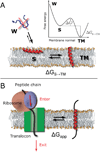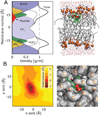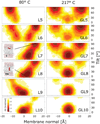In silico partitioning and transmembrane insertion of hydrophobic peptides under equilibrium conditions
- PMID: 21861483
- PMCID: PMC3191535
- DOI: 10.1021/ja204042f
In silico partitioning and transmembrane insertion of hydrophobic peptides under equilibrium conditions
Abstract
Nascent transmembrane (TM) polypeptide segments are recognized and inserted into the lipid bilayer by the cellular translocon machinery. The recognition rules, described by a biological hydrophobicity scale, correlate strongly with physical hydrophobicity scales that describe the free energy of insertion of TM helices from water. However, the exact relationship between the physical and biological scales is unknown, because solubility problems limit our ability to measure experimentally the direct partitioning of hydrophobic peptides across lipid membranes. Here we use microsecond molecular dynamics (MD) simulations in which monomeric polyleucine segments of different lengths are allowed to partition spontaneously into and out of lipid bilayers. This approach directly reveals all states populated at equilibrium. For the hydrophobic peptides studied here, only surface-bound and transmembrane-inserted helices are found. The free energy of insertion is directly obtained from the relative occupancy of these states. A water-soluble state was not observed, consistent with the general insolubility of hydrophobic peptides. The approach further allows determination of the partitioning pathways and kinetics. Surprisingly, the transfer free energy appears to be independent of temperature, which implies that surface-to-bilayer peptide insertion is a zero-entropy process. We find that the partitioning free energy of the polyleucine segments correlates strongly with values from translocon experiments but reveals a systematic shift favoring shorter peptides, suggesting that translocon-to-bilayer partitioning is not equivalent but related to spontaneous surface-to-bilayer partitioning.
Figures









Similar articles
-
The importance of the membrane interface as the reference state for membrane protein stability.Biochim Biophys Acta Biomembr. 2018 Dec;1860(12):2539-2548. doi: 10.1016/j.bbamem.2018.09.012. Epub 2018 Sep 20. Biochim Biophys Acta Biomembr. 2018. PMID: 30293965 Free PMC article.
-
Computed Free Energies of Peptide Insertion into Bilayers are Independent of Computational Method.J Membr Biol. 2018 Jun;251(3):345-356. doi: 10.1007/s00232-018-0026-y. Epub 2018 Mar 8. J Membr Biol. 2018. PMID: 29520628 Free PMC article.
-
Sequence-dependent scale for translocon-mediated insertion of interfacial helices in membranes.Sci Adv. 2025 Feb 21;11(8):eads6804. doi: 10.1126/sciadv.ads6804. Epub 2025 Feb 19. Sci Adv. 2025. PMID: 39970206 Free PMC article.
-
Arginine in membranes: the connection between molecular dynamics simulations and translocon-mediated insertion experiments.J Membr Biol. 2011 Jan;239(1-2):35-48. doi: 10.1007/s00232-010-9330-x. Epub 2010 Dec 3. J Membr Biol. 2011. PMID: 21127848 Free PMC article. Review.
-
How translocons select transmembrane helices.Annu Rev Biophys. 2008;37:23-42. doi: 10.1146/annurev.biophys.37.032807.125904. Annu Rev Biophys. 2008. PMID: 18573071 Review.
Cited by
-
A least-squares-fitting procedure for an efficient preclinical ranking of passive transport across the blood-brain barrier endothelium.J Comput Aided Mol Des. 2023 Nov;37(11):537-549. doi: 10.1007/s10822-023-00525-1. Epub 2023 Aug 12. J Comput Aided Mol Des. 2023. PMID: 37573260 Free PMC article.
-
Structural and functional profiling of the lateral gate of the Sec61 translocon.J Biol Chem. 2014 May 30;289(22):15845-55. doi: 10.1074/jbc.M113.533794. Epub 2014 Apr 21. J Biol Chem. 2014. PMID: 24753257 Free PMC article.
-
Towards a Quantitative Understanding of Protein-Lipid Bilayer Interactions at the Single Molecule Level: Opportunities and Challenges.J Membr Biol. 2021 Feb;254(1):17-28. doi: 10.1007/s00232-020-00151-0. Epub 2020 Nov 16. J Membr Biol. 2021. PMID: 33196888 Review.
-
Transmembrane Parkinson's disease mutation of PINK1 leads to altered mitochondrial anchoring.J Biol Chem. 2025 Mar;301(3):108253. doi: 10.1016/j.jbc.2025.108253. Epub 2025 Feb 3. J Biol Chem. 2025. PMID: 39909370 Free PMC article.
-
Cotranslational recruitment of ribosomes in protocells recreates a translocon-independent mechanism of proteorhodopsin biogenesis.iScience. 2021 Apr 20;24(5):102429. doi: 10.1016/j.isci.2021.102429. eCollection 2021 May 21. iScience. 2021. PMID: 33997704 Free PMC article.
References
-
- Ladokhin AS, White SH. Biochemistry. 2004;43:5782–5791. - PubMed
-
- Wimley WC, White SH. Biochemistry. 2000;39:4432–4442. - PubMed
-
- Hessa T, Kim H, Bihlmaier K, Lundin C, Boekel J, Andersson H, Nilsson I, White SH, von Heijne G. Nature. 2005;433:377–381. - PubMed
-
- Hessa T, Meindl-Beinker NM, Bernsel A, Kim H, Sato Y, Lerch-Bader M, Nilsson I, White SH, von Heijne G. Nature. 2007;450:1026–1030. - PubMed
-
- Hessa T, White SH, von Heijne G. Science. 2005;307:1427. - PubMed
Publication types
MeSH terms
Substances
Grants and funding
LinkOut - more resources
Full Text Sources
Other Literature Sources

